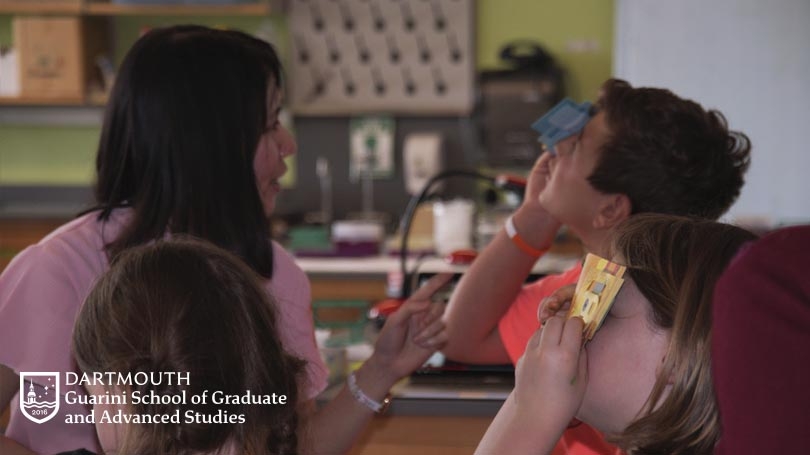
- About
- Academics
- Centers & Programs
- Admissions
- News & Events
- People
Back to Top Nav
Back to Top Nav
Back to Top Nav
Back to Top Nav
This month, young scientists will get a first-hand look at what advanced researchers are doing, and they'll also show and explain their own STEM projects, at two daylong campus events.
The largest gathering, Science Day, traditionally brings as many as 200 young people, accompanied by adults, to the Class of 1978 Life Sciences Center, where they spend hours visiting labs, participating in hands-on activities, and learning about a myriad of scientific career paths. This year's open house, on April 8, is free and open to the public and registration is required.
"We'll have grad students creating and leading hands-on activities related to a wide range of science fields, from physics and astronomy to engineering, math, and microbiology," says Sarah Vandal, a second-year graduate student in the Molecular and Cellular Biology PhD program.
"Most of the activities are geared towards fifth- to tenth- grade students, but Science Day is really open to any grade schooler in the Upper Valley."
Science Day is co-sponsored by Guarini, Bio X Cell, a biotech company based in Lebanon, N.H., and the American Society for Cell Biology.
"We're not only inspiring young people to consider STEM careers, we're also giving graduate students a chance to create compelling education materials while communicating to a broader audience the reasoning behind the scientific processes they employ," says Vandal.
As a member of the Moseley Lab, led by James Moseley, a professor of biochemistry and cell biology, Vandal is exploring how cells regulate their size and shape before dividing.
"I also have a major interest in science education and outreach," she says. "So when I got to Dartmouth, I got involved with the New Hampshire Academy of Science (NHAS). I spent a couple of hours each week working with students, talking through their project ideas and helping them design posters about their findings."
In addition to a STEM Center in Lyme, NHAS has a satellite lab at the Fairbanks Museum and Planetarium in St. Johnsbury, Vt. where middle and high school students can conduct scientific research in summer and after-school programs. In addition, the organization works with regional science teachers and schools to help advance hands-on science and engineering activities. NHAS also supports the attendance of student researchers at the annual symposium of the largest scientific organization in the world, the American Association of the Advancement of Science.
Building Bridges of Knowledge in the Upper Valley
Vandal's involvement with NHAS spurred close collaboration with two Guarini alumnae, Alyson Michael and Kelly Salmon. Michael, who earned her MS in materials chemistry in 2020, is senior scientist at NHAS, a position also held until recently by Salmon, who returned to Dartmouth this winter to become the assistant program director of the Molecular and Cellular Biology Graduate Program.
Salmon, who received her PhD in biochemistry and cell biology in 2018, has been pleased to see Science Day attract more and more people since its inception about a decade ago.
"I didn't have anything like this growing up," she says. "I was definitely interested in science, but I didn't really know about research as a career option until the end of high school. Science Day does a really good job of exposing younger kids to professional possibilities, and the New Hampshire Academy of Science allows those who are really interested to dive deep into actual research experience with a level of independence that you don't normally get until you're in college or graduate school."
One major project underway at NHAS takes students into the woods to study the showy lady's slipper, a rare and beautiful plant that grows wild in the fens of Strafford, among other boggy places.
"We take seeds from the wild, nurture them in the lab and then plant them back out in the wild," says Michael. "We're also working to sequence the genome of the showy lady's slipper, which would be the first species in its genus to have a sequenced genome."
NHAS students will showcase this and many other projects at Dartmouth on April 1 at the New England STEM Symposium. At this symposium, students from across NH and VT who have performed scientific research have been invited to present their work to the broader scientific community.
"It's an opportunity for middle and high school students from northern New England to get together to share their research and meet and learn from professional scientists," says Michael. The day-long event will include poster sessions, a lunch where students will get to meet and network with local STEM professionals, and a keynote address by Barbara Jobst, chair and professor of neurology at the Geisel School of Medicine, on the anti-epileptic effects of listening to Mozart's Sonata for Two Pianos in D Major (K448)."
Working closely with Guarini, Michael says NHAS shows the next generation of scientists that "research isn't just about rote memorization of facts. It's about thinking creatively and working with your hands."